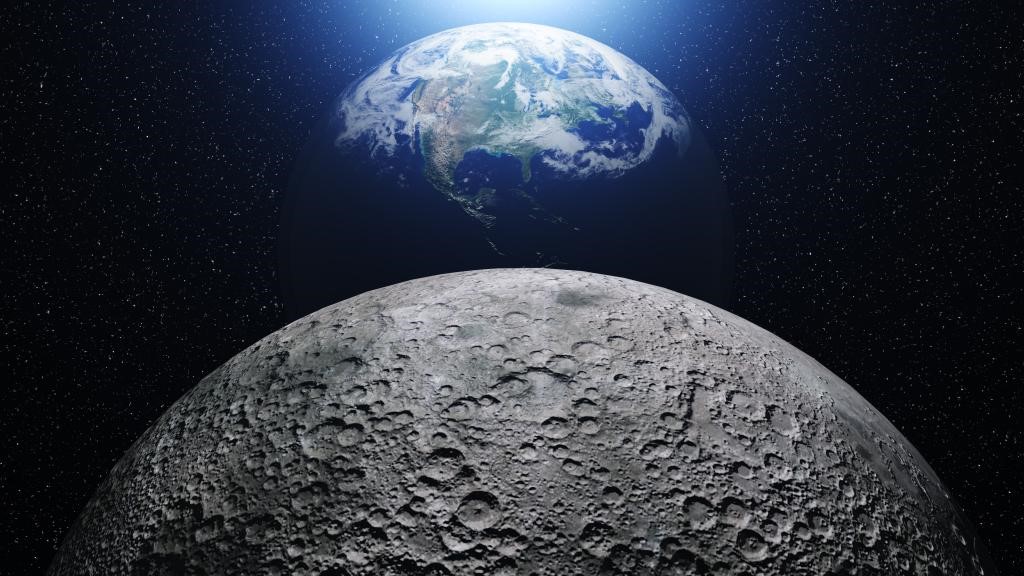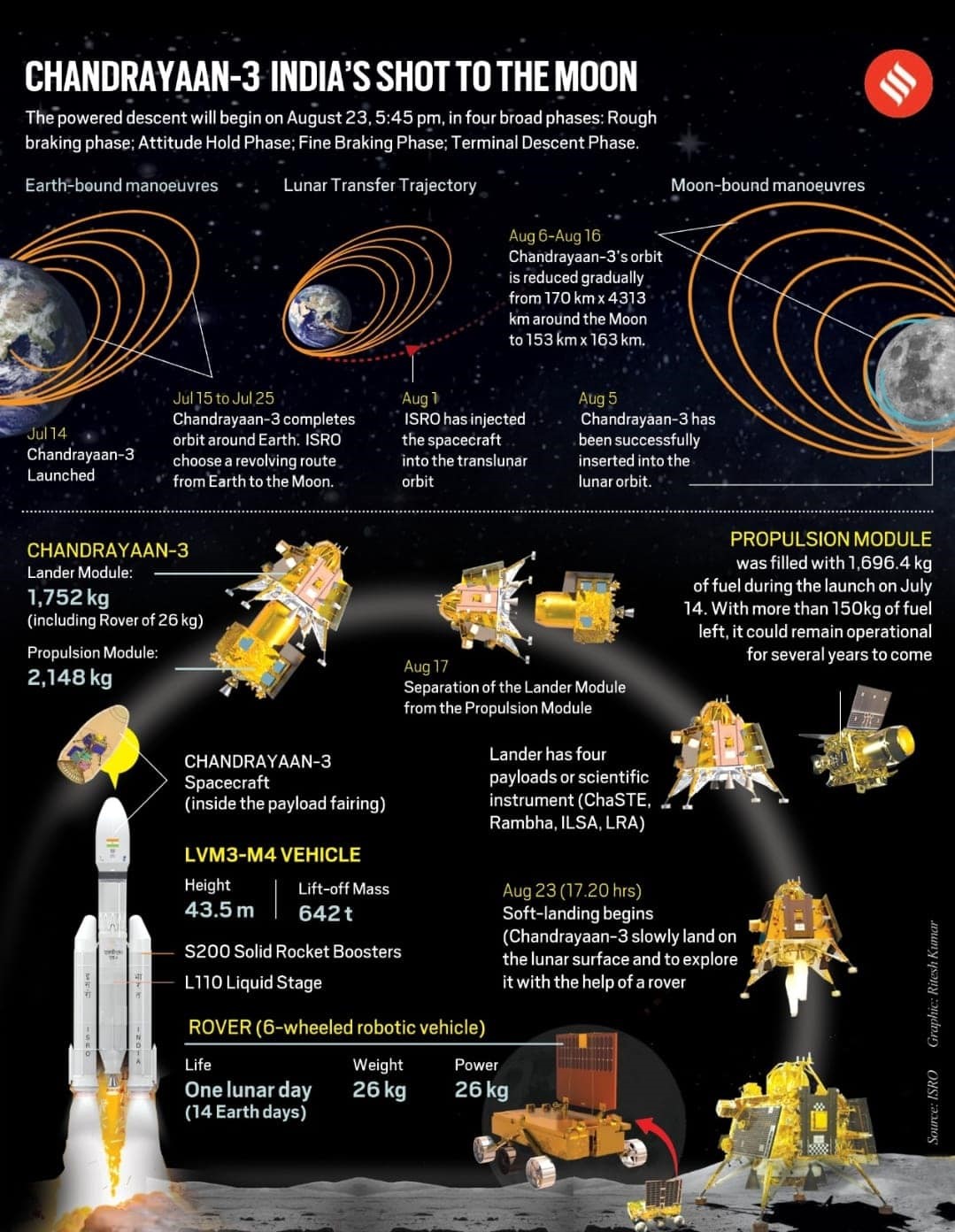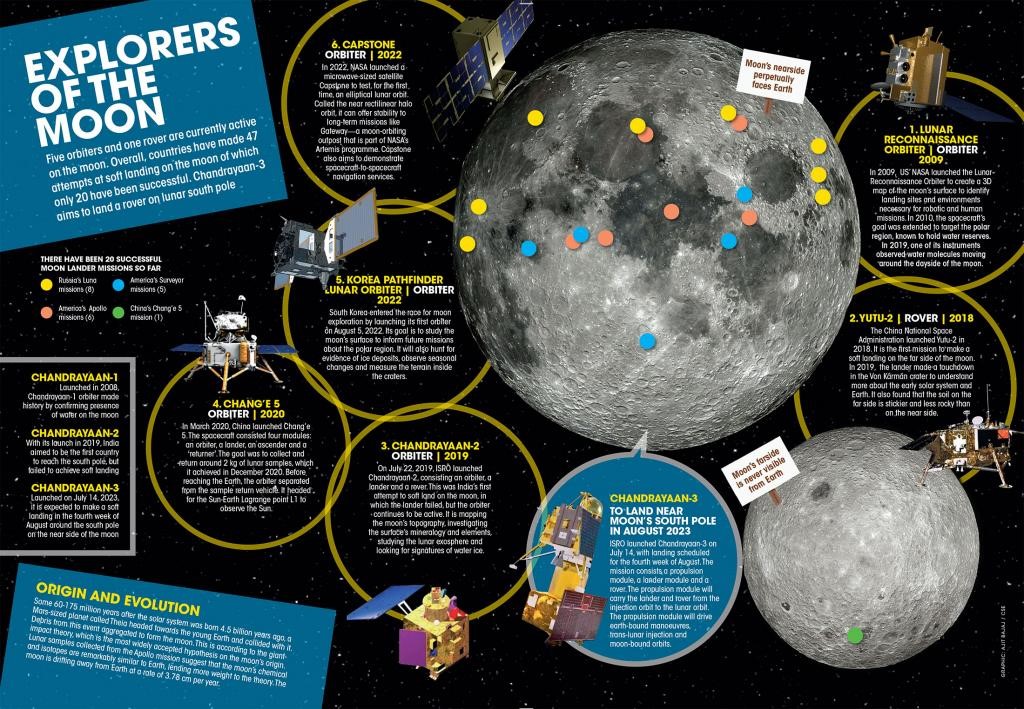
Disclaimer: Copyright infringement not intended
Context
- Launched on 14 July 2023, Chandrayaan-3 etched its place in history when the lander and rover touched down near the lunar south pole region on 23 August 2023 at 18:02 IST.
- This successful landing not only established India as the first country to achieve such a feat but also marked the fourth nation to soft-land on the Moon.
- The achievement is a testament to ISRO's determination and innovation.
Details
A Triumph in Lunar Endeavors
- Chandrayaan-3, part of the Indian Space Research Organisation's (ISRO) Chandrayaan program, signifies a remarkable feat in lunar exploration.
- Comprising a lander named Vikram and a rover named Pragyan, akin to the Chandrayaan-2 mission, this mission focuses on achieving a controlled landing and rover mobility on the lunar surface.
- With the propulsion module transporting the lander-rover configuration to lunar orbit, a powered descent by the lander was the critical phase of the operation.
- The mission encompasses a Lander and Rover configuration, propelled by LVM3 from SDSC SHAR, Sriharikota. The propulsion module carries the Lander and Rover until the lunar orbit's 100 km mark.

Origins and Progression: Chandrayaan-2's Influence
- Chandrayaan-2's launch in July 2019, which featured an orbiter, lander, and rover, set the stage for Chandrayaan-3.
- While the initial lander's trajectory went awry during a landing attempt in September 2019, ISRO's spirit remained unbroken, leading to the conception of Chandrayaan-3 and other future lunar missions.
Global Collaboration: ESA's Involvement
- The European Space Tracking network (ESTRACK), operated by the European Space Agency (ESA), provided support for the mission.
- A mutual support agreement emerged, where ESA's tracking assistance for ISRO missions, including Gaganyaan (India's human spaceflight program) and the Aditya-L1 solar research mission, was reciprocated by ISRO's support for future ESA missions.
- This collaboration underlines the global nature of space exploration.
Mission Aims
- ISRO laid out three primary objectives for Chandrayaan-3:
-
- Achieve a safe and soft lunar landing.
- Demonstrate the rover's mobility capabilities.
- Conduct experiments on lunar surface materials to enhance understanding of lunar composition.

Spacecraft Configuration
Propulsion Module
- Carries the lander-rover to a 100 km lunar orbit.
- Features a solar panel and mounting structure for the lander.
Lander (Vikram)
- Executes the soft landing on the Moon.
- It had four landing legs and four landing thrusters capable of producing 800 newtons of thrust each
- Accommodates the rover and scientific instruments.
Rover (Pragyan)
- A six-wheeled, 26 kg vehicle.
- Conducts diverse measurements, contributing to lunar research.
- Investigates lunar surface composition, presence of water ice, lunar impact history, and atmosphere evolution.
Payloads
Lander Payloads
Chandra’s Surface Thermophysical Experiment (ChaSTE)
- Objective: Measure thermal conductivity and temperature of the lunar surface.
- Information gleaned aids in comprehending lunar surface properties near polar regions.
Instrument for Lunar Seismic Activity (ILSA)
- Objective: Measure seismic activity around the landing site, revealing the lunar crust and mantle's structure.
Langmuir Probe (LP)
- Objective: Estimate plasma density variations in the vicinity of the landing site.
- Langmuir probe plays a crucial role in studying ionosphere and atmospheric phenomena.
Laser Retroreflector Array (LRA)
- Objective: Passive experiment for lunar laser ranging studies.
- LRA aids in comprehending the dynamics of the Moon system.
Additional Payload: Collaboration with NASA
- Passive Laser Retroreflector Array from NASA contributes to lunar laser ranging studies.
Rover Payloads
Alpha Particle X-ray Spectrometer (APXS)
- Objective: Determine elemental composition (e.g., Mg, Al, Si, K, Ca, Ti, Fe) of lunar soil and rocks around the landing site.
- APXS provides insights into the chemical makeup of lunar materials.
Laser Induced Breakdown Spectroscope (LIBS)
- Objective: Conduct qualitative and quantitative elemental analysis.
- LIBS aids in deciphering chemical and mineralogical composition for a deeper understanding of the lunar surface.
Propulsion Module Payload
Spectro-polarimetry of Habitable Planet Earth (SHAPE)
- Objective: To make future discoveries of smaller planets through reflected light, potentially identifying habitable exoplanets.
- SHAPE payload enhances India's contribution to the study of exoplanets.
Mission Progress
The mission progressed through several stages, including launch, Earth and lunar orbit maneuvers, and descent. Notable milestones include:
- Launch on 14 July 2023.
- Lunar orbit insertion on 5 August 2023.
- Lander separation from the propulsion module on 17 August 2023.
- Successful soft landing on 23 August 2023, making India the fourth nation to land on the Moon.
Technological Innovations
- Advanced Altimeters: Laser and RF-based altimeters for precise altitude measurements.
- Velocimeters: Laser Doppler Velocimeter and Lander Horizontal Velocity Camera for speed monitoring.
- Inertial Measurement: Laser Gyro-based Inertial referencing and Accelerometer package for navigation.
- Navigation, Guidance & Control (NGC): Software elements for powered descent trajectory design.
- Hazard Detection and Avoidance: Lander Hazard Detection & Avoidance Camera and Processing Algorithm.
- Landing Leg Mechanism: Enhanced landing leg design for secure touchdown.
Mission Life
- Propulsion Module: Carried lander and rover to lunar orbit, with operation of experimental payload for up to 6 months.
- Lander Module: 1 Lunar Day (14 Earth Days).
- Rover Module: 1 Lunar Day (14 Earth Days).
Key Team Members and Funding:
- ISRO Chairperson: Somanath.
- Mission Director: Mohanakumar.
- Associate Mission Director: Narayanan.
- Project Director: Veeramuthuvel.
- Deputy Project Director: K.
- Vehicle Director: Biju C. Thomas.
- Estimated cost: Around ₹615 crore.

Chandrayaan-3's Landing Choice: Explained
- Chandrayaan-3, India's lunar mission, has drawn attention for its controlled descent strategy and its proximity to the lunar South Pole.
- While it landed on the moon's near side, the Chinese Chang’e 4 mission remains the sole lunar landing on the far side.
Understanding Moon's 'Near' and 'Far' Sides
- The moon's near side comprises 60% visible from Earth due to synchronous rotation.
- The 'far side' is the non-visible half, illuminated during the 'new moon' phase.
- The term 'dark side' is misleading; it was revealed by Luna 3 in 1959.
Contrasts Between Near and Far Sides
- The near side is smoother with more 'maria' (volcanic plains).
- Far side has colossal craters due to asteroid impacts.
- Thinner crust on the near side allowed lava flow, creating plains conducive to missions.
Chandrayaan-3's Noteworthy Landing Choice
- Chandrayaan-3 achieved the closest-ever landing to the lunar South Pole.
- Coordinates (69.36 S, 32.34 E) placed Vikram about 600 km from the South Pole.
- The aim was to approach a 'permanently shadowed region' for potential water-ice discovery.
- The decision aimed to access 'interesting deposits' and harvestable resources.
The Role of Vikram Lander's Position
- Vikram wasn't in complete shadow; sunlight was needed to charge solar batteries.
- The controlled 'soft landing' objective was prioritized.
- Near-South Pole offered the best balance between achieving a successful landing and retaining line-of-sight communication with Earth.
Near-Side vs. Far-Side Landing Considerations
- Landing on the far side would have hindered direct, real-time communication with Earth.
- Chandrayaan-2 orbiter could have been repurposed for relay communication, but it required reorientation and introduced delays.
- Mission objectives, including direct communication and successful landing, guided the decision.
Decoding Soft Landing and South Pole Target
Significance of Soft Landing
- A soft landing refers to a controlled, gentle touchdown of a spacecraft on a celestial body to avoid damage.
- Chandrayaan-3 aims to demonstrate technical prowess by ensuring a safe and damage-free landing on the Moon.
- The Lander's successful soft landing highlights its ability to come to a standstill from high speeds without human intervention.
South Pole as the Landing Site
- The mission's objectives include showcasing a safe landing, rover mobility, and in-situ scientific experiments.
- Chandrayaan-3 is targeting the Moon's south pole for its landing site.
- Unlike previous lunar missions that landed near the equator, the south pole presents challenges due to unique terrain, temperatures, and illumination patterns.
Challenges and Rewards of South Pole Landing
- The Moon's polar regions remain largely unexplored due to extreme conditions.
- Temperature extremes and limited sunlight pose obstacles for sustained operations and instrument functionality.
- Chandrayaan-3's endeavor to land at the south pole opens avenues for discovering clues about the early Solar System.
Moon's Transformative Impact on Evolution: Unveiling Earth's Evolutionary Journey
- Beyond its celestial beauty, the Moon has played a profound role in shaping life on Earth.
- As the small satellite orbits at a distance of 384,400 kilometers, its gravitational influence has exerted far-reaching effects on our planet's geological, biological, and ecological processes.
Tidal Forces and Impact on Evolution
- Despite its weaker gravitational pull compared to Earth, the Moon significantly shapes our planet's day length, seasons, and tides.
- Tides, caused by the gravitational force of the Moon, have been a driving force in the adaptation and evolution of numerous species, including humans.
- Historian Peter Frankopan's book "The Earth Transformed" highlights the Moon's role in both Earth's transformation and the evolution of life itself.
Transition to Land: Tides and Evolution
- The Moon's influence on tides has exposed land at the ocean's edge, prompting life to transition from the seas to terrestrial environments.
- The Institute of Physics notes that tidal effects in the intertidal zone have spurred adaptation and competition among species.
Ancient Tidal Forces: A Catalyst for Evolution
- Billions of years ago, when the Moon was closer to Earth, stronger tides shaped coastlines and contributed minerals to oceans, fostering rapid evolution.
- Lunar-driven tides have also influenced the reproductive cycles of marine creatures, such as turtles whose egg-laying and hatching rely on lunar phases.
Lunar Rhythms and Animal Behavior
- Lunar cycles intricately synchronize with animal behaviors, including migration, spawning, and reproductive activities.
- Marine life, such as fish, crabs, and plankton, demonstrate behaviors linked to lunar phases.
- Wildlife behaviors, including wildebeest mating and migration, align with the Moon's rhythms.
Human Behavior and Lunar Influence
- Lunar rhythms have also been intertwined with human behavior, influencing sleep cycles and, according to some scholars, even fertility.
- Long-term data indicate correlations between lunar light and human reproductive behavior, highlighting the enduring influence of lunar phases.
Climate Stability and Oceanic Balance
- The Moon's gravitational pull aids in heat transport, stabilizing Earth's climate and preventing extreme temperature variations.
- By transporting heat from the equator to the poles, the Moon shapes Earth's climate patterns and maintains equilibrium.
- The Moon's gravitational forces slow Earth's rotation, stabilizing its axis and contributing to the regularity of seasons.
- Absence of the Moon would lead to erratic climate changes, disrupting temperature and daylight patterns across the year.
Moonlight's Impact on Nocturnal Behavior
- The Moon's reflection of sunlight influences nocturnal behavior of various species.
- Predators and prey experience altered behaviors due to changing light levels, affecting hunting, foraging, and reproduction patterns.
- Coral, crabs, worms, and fish respond to specific moonlight phases to initiate species-wide reproduction.
Moon's Influence on Predators and Prey
- Predatory animals, such as lions and bats, show varying activity levels during full moon phases.
- Prey animals exhibit adaptations based on moonlight, altering their visibility and protective behaviors.
Water Delivery and Lunar Formation
- Recent research by the University of Münster reveals that water arrived on Earth through the formation of the Moon around 4.4 billion years ago.
- The collision between Earth and Theia, an outer solar system body, delivered substantial amounts of water and carbonaceous material to our planet.
Tectonic Forces and Oceanic Balance
- The Moon's gravitational pull has likely influenced the setting of Earth's tectonic plates and the distribution of its oceans.
- Gravity's impact on oceanic distribution prevents polar regions from being too warm and equatorial regions from being excessively cold.
Satellite Programs: Pioneering India's Space Era
Aryabhata Satellite Launch (1975)
- Introduced India to the space age.
- Conducted X-ray astronomy, aeronomics, and solar physics experiments.
- Designed and fabricated entirely by ISRO.
- Named after the mathematician Aryabhata to symbolize Indo-Soviet friendship.
IRS Satellite System
- Bhaskar-1 and Bhaskar-2 launched in 1979 and 1981, respectively.
- Laid foundation for Indian Remote Sensing (IRS) Satellite system.
- Enabled Earth observation for applications like agriculture and disaster management.
- IRS-1A, launched in 1988, facilitated land-based imagery using LISS cameras.
Communication Satellites: INSAT and NavIC
- INSAT revolutionized communication, broadcasting, and meteorological information.
- NavIC (IRNSS) initiated terrestrial, aerial, and marine navigation services.
- INSAT-2A (1992) marked first multipurpose satellite; self-reliance in satellite production.
- NavIC began with IRNSS-1A in 2013, enhancing navigation and scientific research.
Launch Vehicle Programs: Propelling India's Space Ambitions
SLV-3's Breakthrough (1980)
- A P J Abdul Kalam led successful launch of SLV-3.
- India became sixth space-faring nation.
- Introduced Augmented Satellite Launch Vehicle (ASLV) concept.
PSLV: Versatility and Reliability
- Developed in 1982, first successful launch in 1994.
- Carried Chandrayaan-1 (2008) and Mangalyaan (2013).
- Reliable workhorse for Indian and foreign satellite launches.
- Pioneered satellite navigation for civilian and defense applications.
GSLV's Evolution and Cryogenic Engines
- GSLV aimed to overcome PSLV's payload limitations.
- Cryogenic engines, developed indigenously, provided greater thrust.
- GSLV Mk-3 (LVM-3) launched GSAT-19 (2017), Chandrayaan-2 (2019), and Chandrayaan-3 (2023).
- Capable of placing 4,000 kg payload in geostationary orbits.
Planetary Exploration: Reaching for the Stars
Chandrayaan-1: India's Maiden Moon Shot (2008)
- ISRO's first interplanetary mission.
- International payloads contributed to lunar exploration.
- Detected evidence of water on the Moon's surface.
- Marked India's presence on the lunar landscape.
Mangalyaan: India's Mars Orbiter (2013)
- Technological demonstrator for interplanetary missions.
- Reached Mars' orbit, showcasing ISRO's capabilities.
- Fourth agency to achieve Mars orbit after Russia, NASA, and ESA.
Chandrayaan-2: Unveiling Lunar Mysteries (2019)
- Orbiter, lander, and rover mission.
- Lander's attempted soft landing unsuccessful, but orbiter remained operational.
- Expanding lunar knowledge with valuable data collection.
The Lunar Exploration Wave of 2023: A Year of Lunar Missions
- The year 2023 has witnessed a flurry of lunar missions, marking it as a significant period for lunar exploration.
- Several countries, including India, Russia, the United States, China, and Japan, have embarked on ambitious lunar ventures, each with its unique goals and objectives.
- These missions promise to deepen our understanding of the Moon's mysteries and lay the groundwork for future lunar endeavors.
Successful and Unfortunate Ventures
Chandrayaan-3 and Luna-25
- India's Chandrayaan-3 and Russia's Luna-25 are two recent missions that reflect both triumph and setback.
- Chandrayaan-3's triumphant soft landing and subsequent rover deployment showcased India's prowess in lunar technology.
- In contrast, Luna-25 encountered a glitch and crashed during its landing attempt, highlighting the complexities of lunar exploration.
Upcoming Missions
CLPS and Lunar Trailblazer
- The U.S. is actively participating in the lunar exploration surge with projects like the Commercial Lunar Payload Services (CLPS).
- This initiative fosters collaboration with American companies to deliver payloads that enhance lunar science, exploration, and commercial development.
- Additionally, the Lunar Trailblazer, an orbiter, seeks to uncover more lunar secrets.
China's Communication Satellite and Japan's SLIM
- China's lunar communication and navigation satellite constellation aims to bolster lunar connectivity.
- Japan's Smart Lander for Investigating Moon (SLIM) mission, combining an orbiter and a lander, aspires to enhance our understanding of the lunar surface.
- Japan's Hakuto-R lander's inability to achieve a moon landing in April marked a setback. Had it succeeded, it would have marked the world's first commercial soft landing on the lunar surface.
Global Lunar Efforts
Current Lunar Assets
- According to ISRO, as of July, six active lunar orbiters exist.
- Among these, China's Yutu-2 rover, deployed by Chang'e 4, remains operational on the far side of the Moon.
Israel's Beresheet 2
- Israel's upcoming Beresheet 2 mission holds promise, aiming to further explore lunar terrain.
U.S.'s VIPER
- The United States' Volatiles Investigating Polar Exploration Rover (VIPER) project targets the Moon's polar regions to study water and other resources.
China's CLEP Chang'e 6 and Hakuto-II
- China's Lunar Exploration Programme (CLEP) Chang'e 6 mission and Japan's Hakuto-II venture are expected to contribute valuable insights to lunar exploration.
Conclusion
Chandrayaan-3's successful landing near the lunar south pole epitomizes the spirit of exploration and innovation that ISRO embodies. The mission's achievements, propelled by advanced technology and a resolute team, deepen our understanding of the Moon's mysteries and pave the way for further lunar exploration. The triumph of Chandrayaan-3 cements India's position on the global map of space exploration and opens new avenues for unraveling the Moon's enigmatic history.
|
PRACTICE QUESTION
Q. Which of the following statements about ISRO's space missions is incorrect?
1. The Chandrayaan-3 mission successfully landed on the lunar surface, making India the first country to reach close to the lunar south pole.
2. Chandrayaan-1, India's maiden Moon shot, featured payloads from international space agencies like the European Space Agency and NASA.
3. The Indian Regional Navigation Satellite System (IRNSS) or NavIC consists of seven spacecraft used primarily for planetary exploration.
Options:
A) Only Statement 1
B) Only Statements 2 and 3
C) Only Statement 3
D) All statements are correct
Answer: B)
|

https://indianexpress.com/article/explained/explained-sci-tech/chandrayaan-3-landing-moon-explained-8904598/






